#frogs ask tag
Text

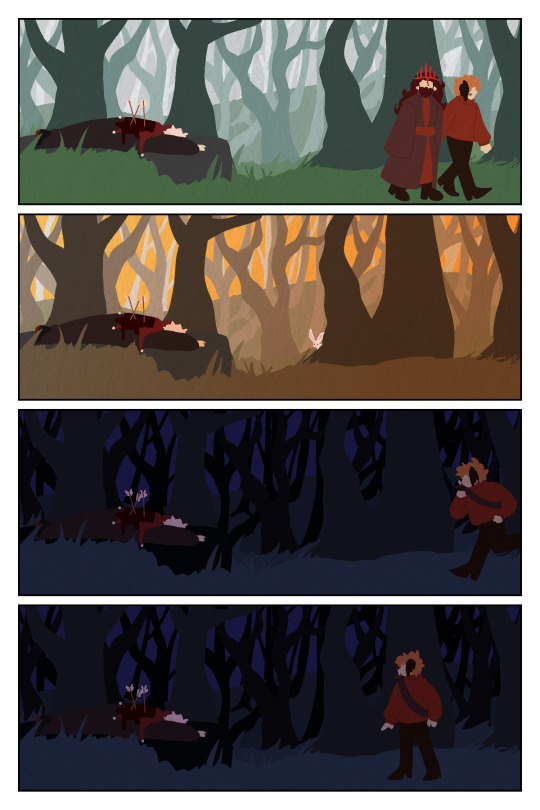
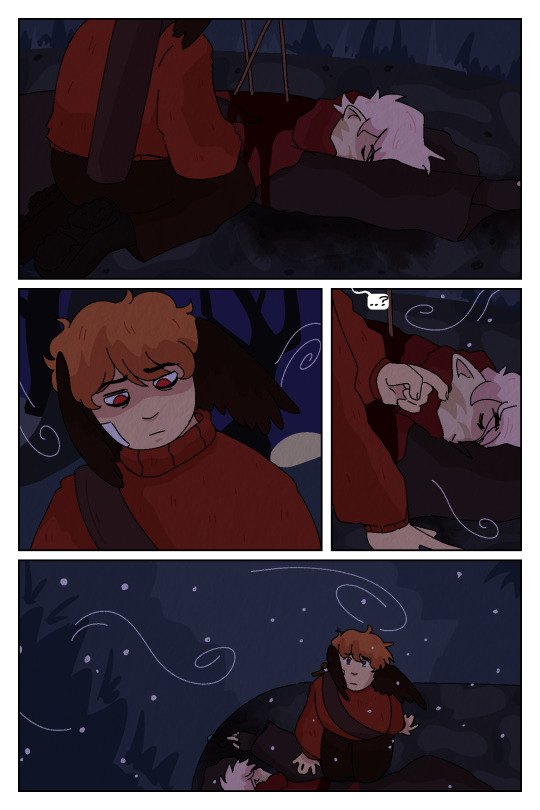

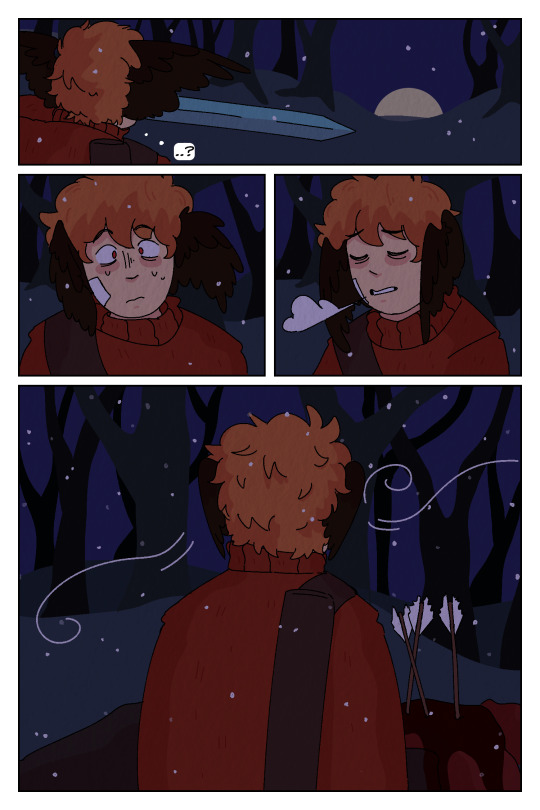

A short introduction comic to a Last Life AU i've been rotating in my mind where Scar is a ghost only Grian can see :)
Part 2
#grian#goodtimeswithscar#last life#llsmp#trafficblr#desert duo#scarian#life series#smallishbeans#this is part 1 of possibly more we shall see#thank u tumblr user bloop-im-a-frog-now for asking about the au in the tags of a previous post#i'm just bad at getting myself to make text posts so i haven't shared much about the au apart from the few drawings </3#ghost scar au#good enough tag for now#my art#blood#death
1K notes
·
View notes
Text

#kirby#frog#ask to tag#daily kirby#my art#digital#hal laboratory#nintendo#I can't help you understand this one either#I'm just vibin dude
209 notes
·
View notes
Note
PLEASE share the frog pics i GOTTA see some boys
many little dudes for u


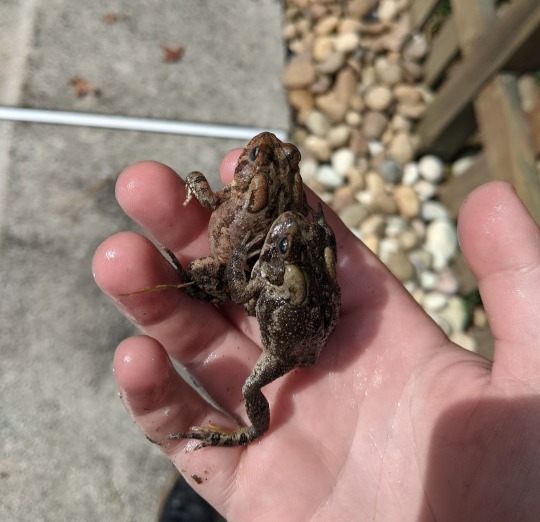

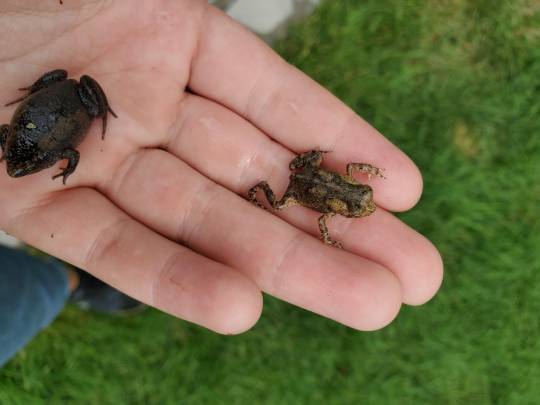
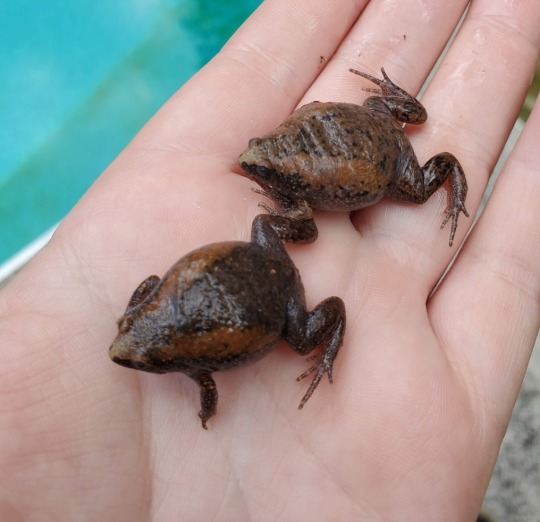
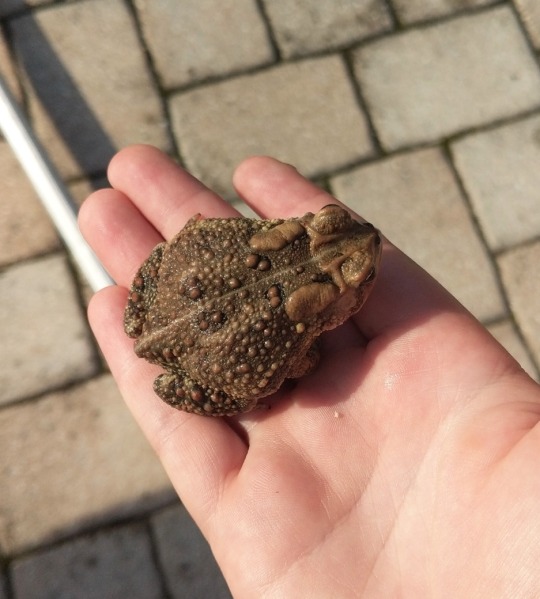

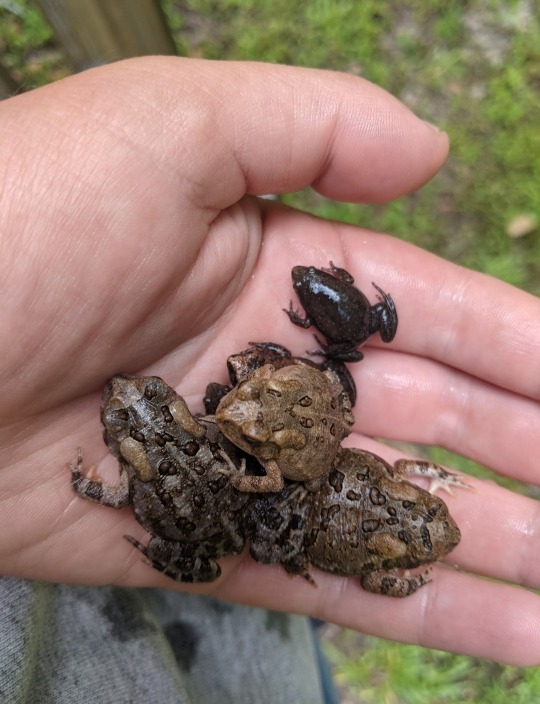
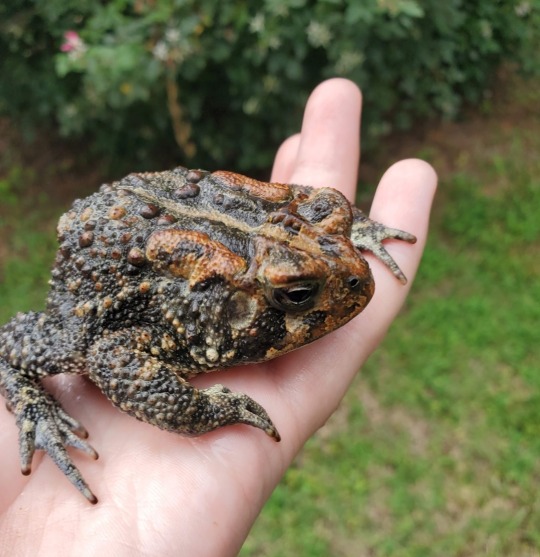
👍
#i wish i had more pics of the piles of frogs lol#but they squirm a lot it was hard#ask tag#the bull frog up top was a pain in the ass to catch omg#it was an algae clean and i didnt want that fucker to get NUKED but she was so goddamn fast#and she kept kicking up algae#but i caught it
213 notes
·
View notes
Photo

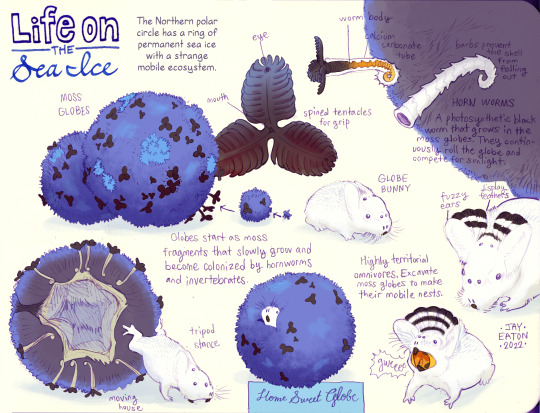
Some Runaway to the Stars worldbuilding. The poles of the avian homeplanet both have permanent sea ice fields, which are difficult for life to colonize for the same reason sand dunes are. The surface constantly shifts (although much slower than a dune) as it's shaped by wind, currents, melting, and precipitation.
In the North pole, the dominant ecosystem on the ice is globe fields, which are full of conglomerate balls of moss and frost tolerant worm plants. They very slowly roll across the ice, being pushed uphill by the worms into sunlight as their thermal mass slowly melts whatever ice they sit upon.
All of the moss globes are host to a suite of small cold tolerant invertebrates, but a small fraction are also nests for globe bunnies. These small endotherms hollow out the inside of mossball and pack it with insulation. They feed voraciously on invertebrates and other mossballs, though they will also trim the "lawn" surrounding their house, to keep it at a manageable size and roundness for rolling about.
Polar avians find the globe bunnies tasty. The watercolor painting here features one of the larger coastal cities on the North pole landmass. It is essentially one large interconnected building, in classic polar avian style.
PATREON | STORE | Runaway to the Stars
#ask to tag#cw blood#cw guns#avians#speculative biology#runaway to the stars#globe bunnies are like a rain frog with ears and fur lol#aliens#jayart
3K notes
·
View notes
Note
You write for jjk right? So tender/soft sex w Gojo ,like imaging him actually having scars yknow with this “I’ll kiss all the scars on your skin” ,I’m down bad for that man ,like he is secretly begging for someone to praise him in the way he deserves yknow ,that man needs someone to love the weak and hurt gojo behind his facade of the strongest 😩😩😩 im going insane 🐸
yes, i do write for jjk and yes, i do write for gojo satoru and yes, i am going fucking feral
gojo satoru who finds his scars to be a sign of his failure as the strongest, a reminder of all of the people whom he failed to protect. he treats each scar not as a trophy of his survival but rather as a sign of weakness. a foolish thought, truly, but even the strongest has his faults at times.
( and there is a reason, after all as you so often joke, why he is called the strongest and not the wisest )
it's rare that you have the time to simply exist together and so, you both try and take as much advantage of it as possible. on the times when you can linger, you always do. even as he begs for you to go faster, tells you over and over again that he can take whatever you give him, that he won't break, but you still go slow. you ensure that he stays still — not that it takes much convincing; all you have to do is ask and he's eager to be your good boy. wanna be your good boy. am i your good boy, yet? — and that he feels every inch of you all over him.
this is one of the rare occasions in which satoru is self-conscious of himself, and you're more than aware of that. so, you ease him into it. first, you keep yourself quiet — easier to be agreed to if you don't give anything to rebuke — choosing instead to focus all your attention on kissing him all over. his throat, his lips, his cheek, his eyelids, his chest, his tits, his stomach, his thighs, his calves, everything. satoru, ever the perfect, pliant boy that he is for you, never tries to stop you. his muscles strain from his efforts to keep still, to take everything you give him, but he's so good at it that you barely even notice. you're too busy peppering kisses all over, hands on his skin so that you can feel more of him.
only once he's calmed down, used to the feeling of your mouth on him, do you begin to talk. you've learned a long time ago that a man like gojo satoru may preen under the attention, but the lonely boy in satoru will always shy away from honest compliments. so, you have to find another way to appreciate him without having him shrink away from you.
so, you kiss his hips, turning a blind eye on the way his breath hitches as your thumb brushes along a dent on his skin there, and you softly murmur, "you're so pretty." right against his skin.
so, you kiss the scar over his chest, right above where his heartbeat echoes through his ribs, ignoring the way he squirms and his gaze averts from you, and you tell him, "your heart's pounding, baby."
so, you kiss at the inside of his thigh, pretending not to feel the way his thighs tremble when you press a little too hard on an old jagged mark on his skin there, and you whisper, "you're so damn perfect." and you forget to tell him that you don't mean it in the way that he's the strongest, but because he's your satoru, but you know that he understands it all the same.
so, you kiss the most recent scar on his throat, the one from one close call or another, and you catch his chin in your hand and force him to meet your gaze so that he listens when you say, "i'm glad you came home."
sex with satoru after that is never the rough, harsh tumble that you would often do when you're chasing after time and desperate to have each other one last time. it's never just a good fuck, one with greedy hands and very little devouring mouths.
sex with satoru after that is always slow, tender, as if you're trying to meld your bones with each other until your entire existence becomes one and the same. it's always nails digging into your back, satoru's low sobs echoing in your ears, and your mouth peppering kisses and gentle worship against his skin.
the world can have tough, perfect gojo "the strongest" satoru.
but you?
you'll have scarred, beautiful, vulnerable satoru, and that is all the more precious.
#also is the frog emoji like one of those . anon symbols#or do you just really like frogs#either way perfectly valid i respect the frog#tagging this too btw anon hope u don't mind#dom reader#male reader#gojo satoru x reader#sub gojo satoru#sub jjk#( asks. )#( thirsts. )
266 notes
·
View notes
Text
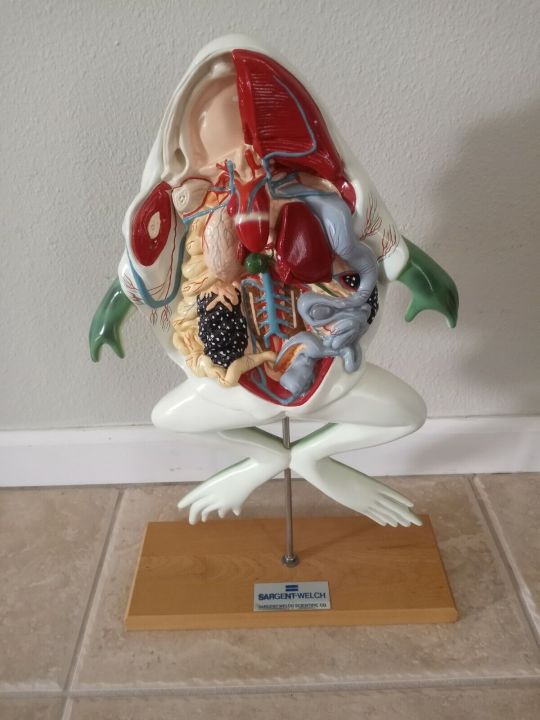
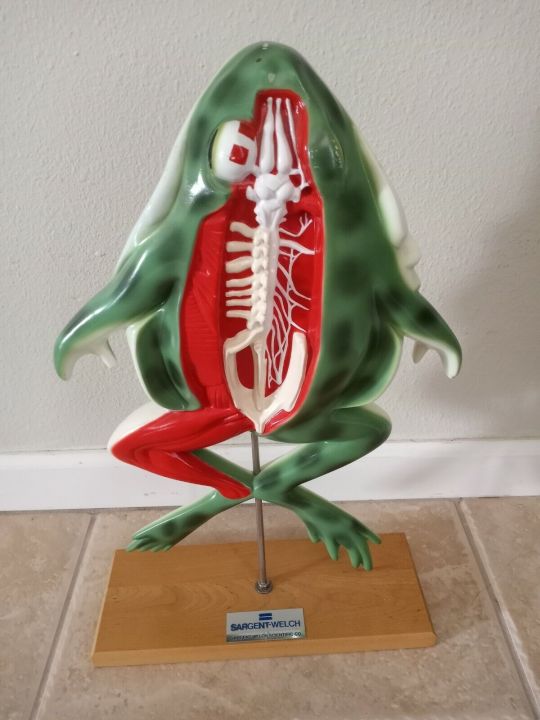
(source)
#anatomical model#frog items#gore#gore depicted#animal harm implied#ask to tag#creepy#medical#paid link
205 notes
·
View notes
Text

lorath and kermit .... save me ..
save me lorath and kermit
#diablo 4#kermit the frog#lorath nahr#diablo iv#the muppets#god ask me 10 years ago if i'd be putting these tags on a post#i'd probably just shake my head
102 notes
·
View notes
Note
I’d love to know about Yulma and how important it is to representation in shounen manga
This has been sitting in my askbox for a couple months (because I am incapable of punctuality), but anon sent this to me back when I was talking about Yulma over on my vnc blog. For those unaware, Yulma refers to Yu Kanda and Alma Karma from the manga D.Gray-man.
So the thing is, to be honest, I don't know if you can say Yulma is/was important for representation. They don't tend to get brought up as an example of representation (except by diehard d.gray-man fans like me, lol) in shonen, and their whole thing is complicated enough that I feel like the queerness of it all flies over a lot of people's heads.
However! They're very important to me personally, and I do think it's kind of remarkable their story came out in like 2010. Because even though their queerness gets overlooked a lot, it's like. really there no matter how you interpret it.
The short version of their very complicated story is that Kanda and Alma are a couple who were resurrected into new bodies. Alma was a woman when they were originally together in their past lives, but is physically male in the present. Kanda is still very much in love with them by the end of their story, which, depending on the reading, makes Kanda very bi and/or Alma very trans.
This sound like something you want details on? If so, let's talk about how D.Gray-man's fan favorite edgy badass toughguy character briefly became the star of his very own heart-wrenching tragic queer romance.
Here's a brief crash course in Yu Kanda and Dgm for the uninitiated:
D.Gray-man is a manga about a group of exorcists (in the loosest and most anime sense of the term) in the 1890s fighting a holy war against mechanical demons powered by the souls of the dead. There are two things you need to understand about this plot for me to explain Yulma:
The Black Order, the secret branch of the church that exorcists work for, has a long history of committing horrific human experiments to further the war effort.
Due to complications of world building, only a tiny number of people can become exorcists, and tracking down new ones is extremely difficult.
Yu Kanda is one of the exorcists, and though not the actual main character (that's the lad in my icon), he's a very important secondary character. Arguably he's the most important secobdary character, since he's the main guy's biggest foil and the first character to play deuteragonist in a major story arc. He's also a huge fan favorite. The character popularity polls that Jump used to do always had him and the mc going back and forth over who won #1 most popular.
Kanda was also a classic edgy toughguy character. His first two scenes are him almost murdering the main guy because he thinks he's an intruder, then complaining about people grieving for their friend too loudly. He never smiles. He argues with the righteous mc about wasting time/energy protecting civilians. He threatens (and delivers) violence on anyone that annoys him. He looks like this:
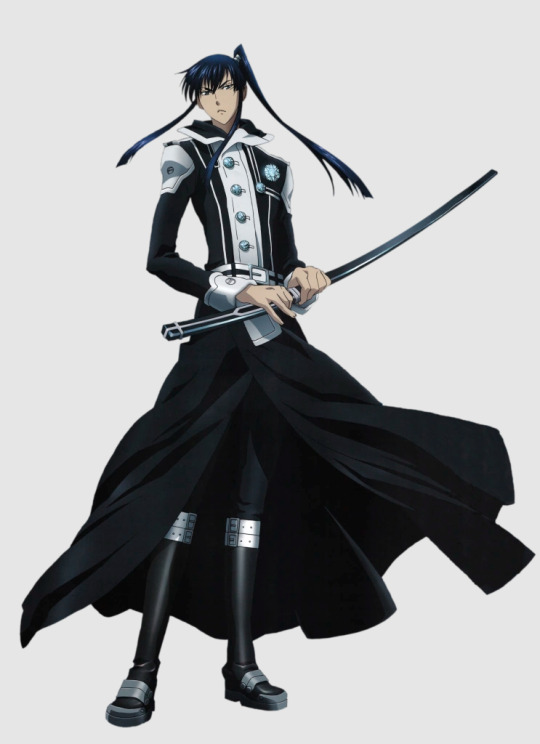
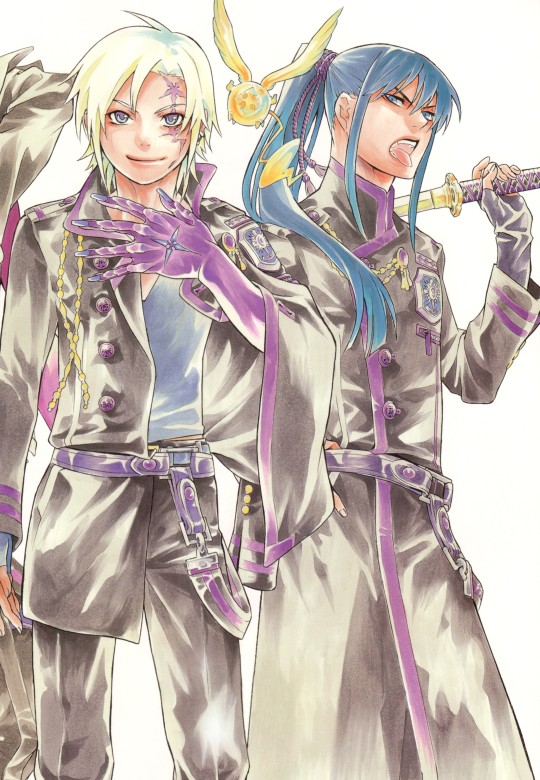
TLDR; Kanda was an adored-by-fans mean badass archetype in a 2000s shonen manga. Not generally the guy you peg for starring in a piece of queer romantic storytelling.
And for the entirety of the original anime adaptation's 103 episode run, for the first 188ish chapters of the manga, you do not learn a single thing about his early life. You learn he joined the Black Order very young, and you meet the mentor that took him in at that point, but although there are little hints, a couple cryptic mentions of him searching for a certain person, his early origins remain a complete black box.
Then came the Alma Karma arc.
This is the point where I start getting into spoilers.
To make a very long story short, the Alma Karma arc reveals that Kanda is one of the Black Order's human experiments. The Order ran a secret project 9ish years before the start of the series in which they essentially tried to re-use dying exorcists (since finding new ones is so hard). They took the bodies of dying or recently deceased exorcists and harvested their brains, implanting those brains into new magically grown child bodies.
Key to this project—the second exorcist project—is that these newly grown second exorcists were not supposed to remember anything from their previous lives. Kanda, however, recovered a few hazy memories from his past self. Most importantly, he can recall an unclear image of the woman that his past self was in love with. This memory gradually becomes Kanda's reason to live. He wants desperately to find and meet that person.
Now, aside from Kanda, there was one other successfully revived second exorcist. This was a boy named Alma Karma.
Over the course of their brief shared childhood, Kanda and Alma become extremely close. However, due to a series of horrible events that I'll spare you the details of, Alma is eventually driven to murder-suicide. He wants himself and Kanda to die together to spite the Order, and Kanda almost lets him do it.
The one thing that keeps Kanda from letting Alma kill him, the thing that drives him instead to kill Alma, his most beloved and only friend, is that he can't bear to die without finding that woman again.
Have you figured out the twist yet?
9 years later, in the present, Kanda discovers that he didn't actually quite kill Alma. The Order kept Alma secretly half-alive in order to do more dubious experiments. And, more importantly, when they meet again, Kanda discovers the truth. The woman that he's been searching for his whole life, the woman he's in love with, the woman he tried to kill Alma in order to find, was also killed and made into a second exorcist. And her brain was placed into the body of Alma Karma.
After quite a lot more violence and tragedy, Kanda and Alma end their story arc by running away together on their deathbeds. Alma dies, for real this time, in Kanda's arms, and his last words are to tell Kanda he loves him. These words are presented as something Kanda hears from both the boy and woman versions of Alma's soul.
So! At the end of a very long and complicated story, one thing holds true: Kanda and Alma are in love. As passed down from their past selves, they are specifically in romantic love. They were a couple. And to speak as a fan, the sheer absolute devotion to how Kanda's love for Alma is presented is seriously intense and moving.
Now, given the absolute hell that is Alma's life, gender identity is frankly the last thing they have time to worry about, so it's hard to say how the whole "literally a woman's brain in a male body" thing might have settled for them if given time to think about it. But that is inherently a pretty trans narrative. And given the whole Alma gender situation, there's simply no reading of their whole situation where neither of them is queer.
If you take present day Alma as a guy, which is more or less how he's presented in canon (though again, who knows how he would've felt about that male body in different circumstances), then congratulations! You've got mlm in your shonen manga. They were straight in a different life, but now one of them's a dude, and they are still deeply in love with each other. They've even got not one but two "let's forget it all and run away together" scenes, just as every mlm couple seems to have.
On the other hand, if you go with the angle that Alma's still a woman based on her mind/soul, even in her new body, then Kanda may not be canonically queer, but Alma is inarguably trans. Again, literally a woman's brain in a male body. It may not be how most people end up trans, but that doesn't change the facts of her situation.
You see what I mean about how they're undeniably queer, but also kind of easy to miss? There's so much other insane shit going on in their story that Alma's whole gender situation can get passed over. Plus, you can look online to this day and find people arguing that Kanda's not "technically" explicitly in love with the present day male version of Alma, since he doesn't 100% unambiguously say as much. I love reading comprehension.
Also! As a possible extra reason for why people don't talk about them much, the official English translation of the manga translated Alma's final "I love you" very differently. There's always a lot of nuance and argument when it comes to translating "大好き" into English, but given the full context of their relationship and the scene it's in, Viz's handling really sets off the censorship bells in my head.
Here's the different versions (Japanese then fan then official), if you want to compare:
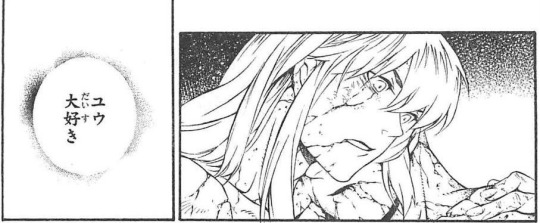
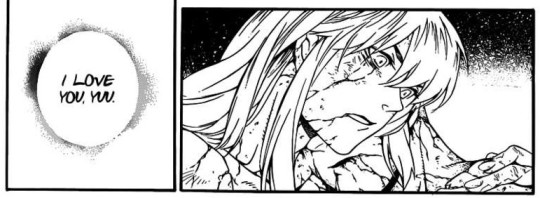

Nothing more classically queer than censorship by way of questionable translation 🙃.
At the end of the day, Kanda and Alma are in kind of a strange middle ground. They're each in love with the other one, but the whole second exorcist brain transfer situation makes it complicated enough that people argue their feelings aren't explicitly romantic (and thus not gay) in the present. Alma is literally a woman's brain implanted in a male body, but we don't have time to dwell on the gender complications of all that because of the hell that is the rest of their life. They're canon but not canon—queer people whose stories don't have space for them to be queer.
However, given that all this messy, tragic ambiguity was published in a fairly popular shonen manga back in 2010, it still feels kind of remarkable to me. Alma is somewhat an antagonist (it's complicated), and he dies at the end of his arc, but once again, Kanda was/is the fan favorite! And when he re-enters the main story after Alma's death, he's more important than he's ever been, and his history with Alma continues to be a huge part of his character.
Katsura Hoshino took the much-beloved edgy toughguy character from her long-running shonen series and, after keeping his origins secret for such a long time, confirmed that his whole life has revolved around love this entire time. Almost every facet of his character can be traced back to his love for his lost best friend or his yearning for his past life's missing partner. And then she reveals that the best friend and the partner are one and the same.
You can go back and forth about the degree to which they work as representation, but in any case, I think their story is something people ought to know about. It's romantic and it's heart-wrenching and it's fucking wild, especially given the context in which it was published (a Shonen Jump spinoff in 2010). I never see anyone besides the few remaining hardcore dgm fans talk about them, and I think that's a shame.
So anyway, that's tale of one of the most insanity-inducing romances I've ever seen put to paper. I love queer people.
Here's some choice pages if you want to cry with me (the last two are a sequence):
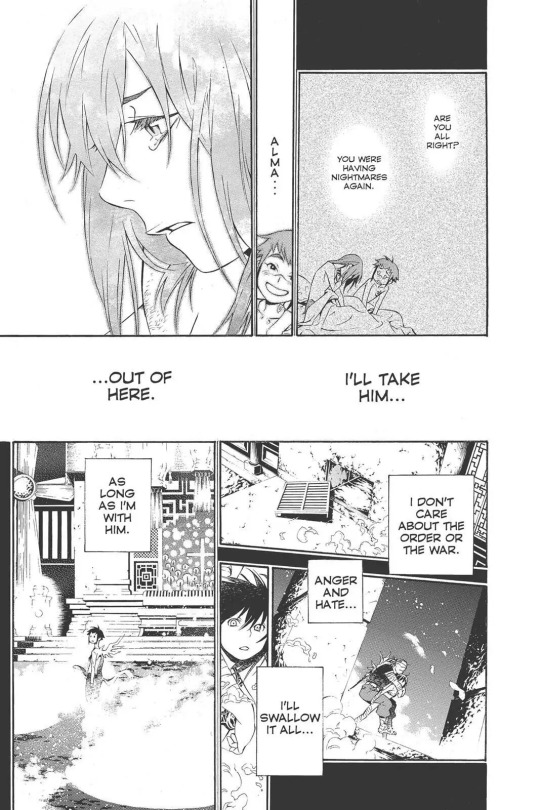
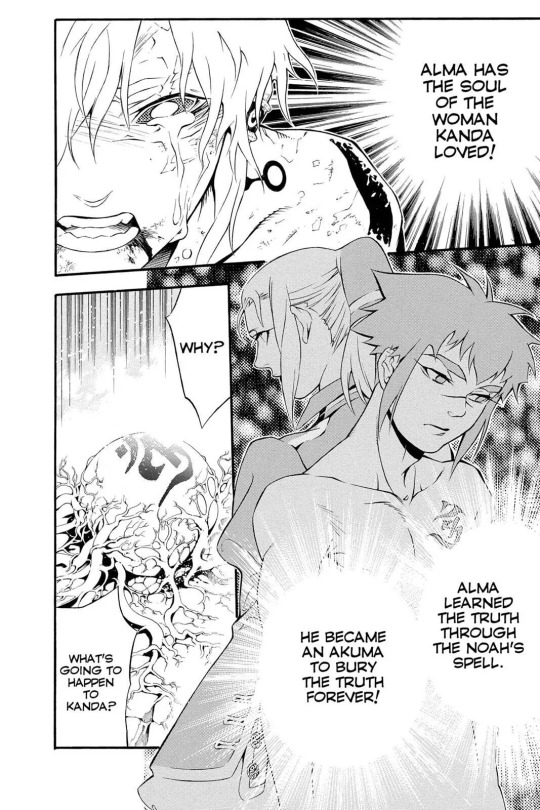
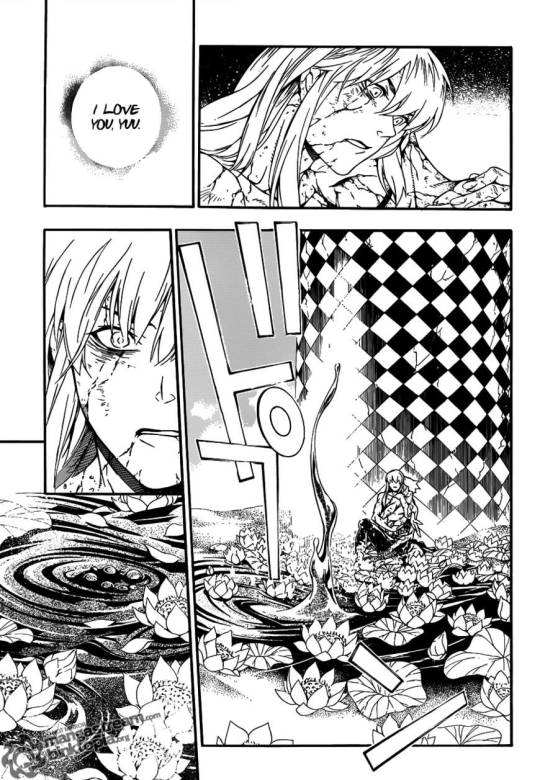
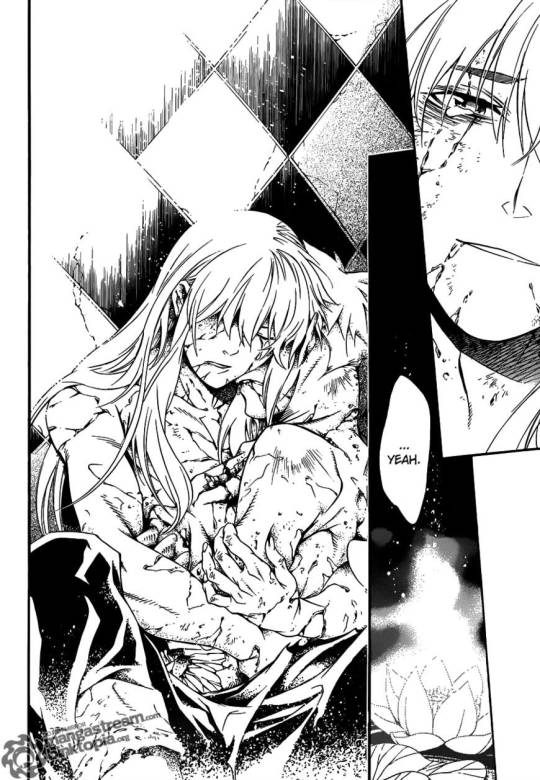
#followers!! I know my demographic#I know that most of y'all are Tragic Queer Romance Enjoyers#and if that describes you. you should read this post#come learn about a truly wild piece of manga history#I bring you the gift of discovering Yulma without having to read almost 200 chapters of shonen manga for context#don't pass this up <3#dgm#d.gray-man#yu kanda#yulma#alma karma#invasion of the frogs#also I really hope that at least one of the besties reads this and has a Realization about who/what my queue tag is a reference to#maybe I flatter myself to think that anyone remembers what my queue tag is. but I just think it would be funny <3#also also. I really did not intend for this post to turn into an entire essay when I started writing it#so uh. whoops#ID in alt text#anon#ask
176 notes
·
View notes
Note
Do you have like, an alt where you post other art?
there isn't really any other art to post ^^;
(except stuff i do for work which i'm not sharing because 1. NDAs and 2. it's tied to my real life identity, which i like to keep separate from my internet frog art)
i used to draw and post more elsewhere, but nowadays i don't really feel like it. i'm creatively fulfilled by work and amphibians :)
#not art#not frog#dont remember my answering asks tag. if i had one#also when i DO want to draw other stuff it goes here too lol because i add a frog or say 'my blog my rules it an honorary amphibian'
59 notes
·
View notes
Note
i am very curious about your thoughts on various utena/atla character parallels… every once in a while i see you offhandedly compare like.. korrasami and utenanthy and i’m like HOLD ON this is so true! if you have any further ideas about that i would LOVE to hear them. i honestly don’t know how big the audience is for rgu/atla analysis but i am definitely part of that audience. 😭
yesss i can't believe you're literally the first person to ask me this lately i've been making rgu references on like, every single post i'm shameless!!!!! over the summer i even wrote (like 95% of) an essay comparing sokka and nanami (tldr; they are meat) and i have yet to revisit it (bc i'm scared tbh) but i will post is eventually that is a PROMISE (for an audience of 5 people). also before we go any further my utena blog is @saionjeans and we have fun there. also, i have some utena/atla crossover art here and here, so check that out if you haven't already. the rest of this post will be scattered thoughts because my nanami-sokka essay will be doing a lot of the in-depth analytical work and i don't need to rehash that all now. but also, because i have never not once in my life heard of brevity, i did write a bunch of mini essays anyway, because of course i did.
korrasami and utenanthy: love and abuse
i compared utenanthy to korrasami a couple times, most notably in this post where i talk about how meaningful their relationship is despite being (arguably) underdeveloped, and then in the tags i still have to acknowledge that utena and anthy nonetheless did it better 17 years prior. but i do think that there is so much to be said for utena-korra and anthy-asami as two young women who are both set up to be "special" but in a way that denies and restricts them from their own humanity, cloistering them away from the outside world and making them more vulnerable to abuse. i talked pretty recently about how asami's abuse is really shrugged under the carpet in a way that pisses me off if i think about it for too long. rgu does such an incredible job of gradually exposing that abuse and its effects on society, not as a deviation from the norm (of the nuclear family, of the romance, of the school, etc.) but in fact a common symptom of it. lok does not critique the nuclear family in any meaningful way despite setting up so many different areas through which such a critique could be facilitated (made worse by the fact that atla sets such a fantastic precedent). but anyway, enough about lok (and how she disappoints me).
2. miki & kozue and katara & sokka: siblings and memory
in my sokka-nanami essay i talk about how various characters can be read to embody various analogues, but how my focus in that essay is primarily to draw a parallel between sokka and nanami by using the framework for gender/patriarchal logic rgu establishes. however, i also talk about how azula can be read as a nanami (or even an anthy) figure, as well as how katara and sokka can be read as miki and kozue (katara = miki and sokka = kozue, obviously) (and note that kozue and nanami are significant foils/mirrors too). i mean, they even have a similar light blue (to signify naïveté, innocence, childlike wonder) versus dark blue (to signify cynicism, jadedness, resigned subsumption into harmful norms) color scheme going on. the Special sibling and the afterthought. (although before going forward i do want to be clear that i am in no way alluding to any incestuous undertones wrt katara and sokka, and i would even argue that the allusions to incestuous desire between miki and kozue are more complex and nuanced than simply reducing it to mere perversion. but that's beyond the scope of this ask lol)
i know that some people might bristle at my comparing katara to miki (baby misogynist, little freak) but miki really exemplifies the trope of the "sunlit garden" in the same way that katara exemplifies that trope in atla. miki isn't the narrator of course (akio is), but the central motif of desire staked to an illusory formative memory since lost that defines a character's motivations and self-becoming is first properly introduced (not including the utena meeting dios intro) and defined through his obsession. in the same way, we are introduced to the world of atla through katara's formative memories, her desire that motivates her self-becoming also being an illusory formative memory, as well as a tale she longs to replicate ("the four nations living together in harmony"). katara, like miki, is defined by her naïveté and childlike innocence, her somewhat reductive desire to be noble and heroic, and her need to flatten everything into a clear-cut narrative wherein she is always its heroine. like miki, she resents her sibling for being transformed into a more cynical version of themselves in accordance with society's pressures (in kozue's case, it's the inescapability of patriarchy, whereas in sokka's case, it's... a lot of things), and longs for a time when they were "truly happy" and playing together (playing piano, playing in the snow, you get it).
both kozue and sokka heavily subscribe to patriarchal logic and comport and reduce themselves in accordance with the dictums of a world they consider truly inescapable. kozue seeks power within her limited frame, whereas sokka only seeks power insofar as it allows him to assume his very narrow role of protector, but they both assume those limitations to be ontological and fixed in a way that does not allow them to see past it. however, the lack of empathy both miki and katara refuse to attempt in understanding their worldviews, in no way making an effort to broach that misunderstanding instead of simply letting the chasm between them fester, nonetheless implicates them equally. after all, they too both adhere to their own limited worldviews, only in their worldviews they are fundamentally special and thus beyond reproach. sokka and kozue are both integral aspects of katara and miki's sunlit gardens, and their idealized return to a picturesque nostalgia involves a transformation (or regression) of sokka and kozue into their more innocent former selves. and sokka and kozue are in turn obsessed with katara and miki, the central figure around which their identity and actions revolve.
through this framework, aang thus becomes katara's anthy (aangthy, hehe), as the embodiment of katara's hopeful/nostalgic ideal of heroism, companionship, and the idealized promise of a distant irretrievable past. like anthy with kozue, aang "replaces" katara's longing for the softer, more innocent version of her brother with aang's friendship. like miki with anthy, katara possesses romantic feelings for aang despite his functioning as a replacement for sokka before he became a shell of his former self (or kozue before she became... sexually active). this is because katara, like miki, idealizes the patriarchal narratives that dictate that all significant relationships be either romantic or familial (or both). she wholeheartedly subscribes to this notion, hence why she attempts to subsume everyone who can meaningfully fit into her narrative framework as either a lover (aang, haru, jet, zuko for all of 2 seconds) or a pseudo family member (aunt wu, hama, pakku, toph, etc etc.), replicating those dynamics as many times as she needs to to make them fit within her two dimensional tapestry. and crucially, coming face to face with yon rha subverts that, because she recognizes the messy humanity spilling forth from the neat boxes she puts people in, and must thus contend with her own role in her narrative. of course miki, being a side character and not the narrator, certainly not the hero, does not get this luxury. and he must find a way to grow up anyway.
3. akio and ozai: patriarchy
there's something truly incredible about how both akio and ozai manage to inflict psychological harm upon every single character in their respective shows, even if they never interact with those characters directly. their reach is vast and spindly; it cannot be overestimated. and yet, ozai has only reigned for about six years. akio is only acting chairman of ohtori academy. they are not patriarchy itself, but merely its signifier. and obviously their modes of embodying patriarchy differ in many respects: a school is not a nation (despite the similarities), and a father is not a brother (despite akio being father-like). ozai is defeated by by being stripped of his technology of violence, whereas akio is not "defeated" in a literal sense (although i suppose anthy driving a car through his ghost and exploding him into a cloud of roses does make quite the statement), anthy merely leaves. and yet, in both instances, they are both forced to succumb to their own limited ideology regarding what constitutes power. if ozai lacks firepower, he lacks control over his subjects and the right to sovereignty. if akio's control is challenged, if people realize that they can just leave, that the ends of his world are entirely arbitrary, he no longer has the power to abuse and exploit and use others for his own ends.
the metonymic signification of patriarchy figured through both ozai and akio in dual ways further emphasizes their respective roles. ozai is both king and father, akio is both (acting) chairman and (acting) father. patriarchy dictates every aspect of [a patriarchal] society: from interpersonal dynamics to the nuclear family to the school to the state to the world. what makes both akio and ozai so brilliant in this regard is the fact that their influence is reflected in all these facets. ozai abuses every member of his family individually; controls them as a system; inflicts his (family's) propaganda onto the fn education system, rewriting history with (almost) no one to disprove him; inflicts his imperialist agenda both within the fire nation (ruining local economies through industrialization, forcing citizens to conform to restrictive roles, inflicting violence through occupation) and beyond it; he refers to the world as "my world," as if he is its creator, its owner, or its god. and in many ways, he is. akio similarly abuses everyone interpersonally (most notably anthy, touga, and utena); subsumes utena into his nuclear family system so that she cannot leave; uses the academy as a site of control in which adolescents are forced to comply with socially codified norms and thus made more vulnerable to the influence of adult authority figures (especially those who emphasize their individuality or inherent specialness when compared with the rest of the student body); operates ohtori as a sort of nation wherein patriotism is reified through the use of uniforms, affiliations, sociopolitical hierarchies, and an acting government (the student council); and defines himself as the creator/owner/god of his world. to be end of the world. to embody not an apocalypse, but a cage.
ozai and akio both fashion themselves the entire world, but it also makes them more vulnerable to resistance, to any mode of critique that points out the obvious: no, you're just one person, and the logic you use to dominate others is deeply, noticeably flawed. it's a logic that they exploit but that in turns exploits them, as they have so deeply internalized it that they can no longer immunize themselves against any kind of resistance. ozai claims that there is no room for an air nomad in his world, which is why aang defeating ozai through the pacifist values of his people and not through his greater power (which would nonetheless be subscribing to ozai's logic, and thus letting him win ideologically if not physically) is so crucial in shattering ozai's paradigm. just as utena, as someone who refuses to conform to the strict, arbitrary, and violently enforced norms of patriarchy, can so thoroughly disrupt akio's control by resisting him. just as anthy can by leaving. akio remains in his cozy little coffin, exerting meaningless control to uphold the hollow puppet of his ego.
people sometimes joke about how long it takes for zuko to recognize that the burning off of half his face was "cruel" and "wrong," but it's not that zuko didn't find it painful, it's not that zuko didn't fear his father, it's not that zuko idolized his father beyond reproach. he questioned his cruelty, in fact he did so constantly. he simply saw no other way to live. he had no conception of a world beyond ozai's defined limits, had no choice but to believe ozai's dogma and loathe himself for not sufficiently adhering to it. similarly, people often ask "if anthy could leave all along, then why didn't she?" because she, too, was trapped in a coffin of her own self-loathing. to leave an abuser is not as simple as simply stepping beyond the threshold and never looking back. first, you must locate the threshold. then, you must find the courage to look beyond it. i briefly touched on azula being an anthy figure before. well, i think that she is. just because she has yet to see beyond the threshold does not mean she does not find her limits. and yes, its not triumphant, and yes, her facade that masks her pain and fear is shattered, but ultimately, that breakdown is a good thing for her. because that's her first step to freedom.
4. the sunlit garden as mythmaking events
i talk previously in this post about the motif of "the sunlit garden" in rgu vs what i like to call "a mythmaking event" in atla, and i do want to elaborate on that slightly. i provided a link to a post on my utena blog going into what the sunlit garden "is" for each principal character, and atla has a similar mode of communicating these nostalgic desires and idealizations that motivate self-becoming, largely through flashbacks. for aang, it is quite obvious, as his memories of a before and after are (temporally, although not psychologically) fragmented by an entire century. that disconnect severs the two versions of himself quite neatly. those memories with gyatso and the other air nomads (as well as with child bumi, and with the mysterious kuzon) are his idealized past, his "sunlit garden," whereas the storm is his mythmaking event, the point in his life where his choices collide with his telos. there is no going back.
katara and sokka have a similar sunlit garden, their snowball fight being the last truly happy memory they have before the black snow falls and their childhood innocence is severed from them forever. kya's sacrifice and murder is katara's mythmaking event as she then chooses to assume the mantle of her mother who took her place, decides to become the greatest waterbender possible to compensate for surviving the genocide, and chooses to be a hero so that the collective memory and sacrifices of her people will not be in vain. like utena, she witnesses pain and suffering at a very young aged and is moved to become a hero so as to mitigate that suffering, even if her own formative tragedy can never be rectified. also like utena, she idealizes a seemingly utopian past wherein violence was more covert and thus presented itself as more ideal (the time of princes vs the time of harmony). her naïveté and persistent idealism are both her downfall and her greatest virtue. she refuses to accept the true state of the world to the point of blindness, but it is also that refusal to accept it that allows her to force the world into a kinder shape.
as for sokka, his mother's death was also a formative trauma, but his true mythmaking event is when hakoda leaves for war with all the other men of his tribe. hakoda tells him that "being a man is knowing where you're needed the most, and right now, that's here, protecting your sister." it's not a rose crest ring, but it may as well be. from that moment onward, sokka officially comports his identity into being his sister's protector, which is how he thus defines his manhood. and of course, being his sister's protector means being a martyr, because the precedent for "protecting katara" that has already been established is, well, dying for her. like aang being the avatar and the last airbender and katara being the last southern waterbender, sokka is thus defined by his necessity (ie, usefulness to others) as well as his isolation – not only the "last warrior/man" of the swt, but also via his own process of depersonalization and self-dehumanization as he attempts to fully embody his role as an eventual martyr.
zuko's mythmaking event is, of course, branded onto his face. in fact, zuko essentially assumes both katara and sokka's mythmaking events by first being irrevocably altered by his mother's sacrifice, and then being all the more transformed by his father's decree as he attempts to dictate what kind of man zuko needs to be. his "sunlit garden" is also shown to us in flashes: memories of a (literal!) sunlit garden, of turtleducks, of his mother's gentle guidance, of happier times on ember island, on his father's hand resting on his shoulder with pride instead of malice. it is unclear just how truthful these nostalgic memories are. obviously, his family was never actually happy. ozai had always been exerting control over them, even if his violence was once more obscured. we never see azula's sunlit garden, for instance (although i'd argue that she and zuko possess the same mythmaking events), and i cannot help but wonder whether it's because, like touga, she never actually had one.
finally, some honorable mentions must go to the following: toph, whose sunlit garden is also her mythmaking event, as she learns from badgermoles how to hone her gift and reject the rigid societal impositions that seek to limit, repress, and control her. hama, who never attempts to return to her sunlit garden in the swt with kanna, despite her freedom as established in her mythmaking event of teaching herself to bloodbend; she knows that she is irrevocably altered, and thus she can never go home again. appa, whose sunlit garden, of playing with the other bison at the southern air temple, occurs in conjunction with his mythmaking event of meeting aang and becoming the avatar's animal companion.
all of these events are depicted through flashbacks wherein the consecutive shots between flashback and present day mirror the character who is having the memory in the past and present, overlaying their younger face onto their current face with identical framing. i'm too lazy to compile a bunch of screenshots here, and i couldn't find the post i'd seen previously that had done so, but if you're as familiar with atla as i am, then you already know exactly what i'm talking about. this device is so effective particularly because it exercises restraint. every flashback in atla is crucial because it signifies either a sunlit garden or a mythmaking event that motivates the character its focalizing in the present day. atla is economical with its flashbacks, but not withholding. like with rgu, flashbacks in atla are used with a specificity of purpose, and illustrate their points in clear, precise ways. just because atla is not as overtly metatextual with its central themes of narrativization, nostalgia, idealization, bias, and storytelling, does not mean it is not present, and in fact, overt. ranging from katara's role as narrator to the fire nation propaganda aang attempts to correct in school, the use of memory and illusion is crucial in illustrating how atla functions as a narrative about heroism, legacy, and challenging dominant myths through preserving cultural memory under an imperialist regime.
5. final thoughts
obviously, i could go on forever. there is simply no limit to my ability to unpack and dissect these two shows (hence, my sideblogs dedicated to doing so). i haven't even talked about zuko as an analogue to saionji with regard to their latent homosexuality, misogyny, violence, and struggle to conform to a patriarchal ideal. and i barely touch on katara as an analogue to utena with regard to their naïveté, heroism, myopia, persistence, and somewhat misguided desire for justice (through her terms specifically), although like kozue and nanami as mirrors wrt sokka, her traits that i describe when comparing her to miki also map onto utena in many ways – except of course, utena, unlike miki, is also the "hero," and thus has the same destabilizing revelation regarding the banality of evil that katara undergoes in "the southern raiders." moreover, i only discuss one central motif in utena, because i think the sunlit garden is the trope that maps best onto the thematic work atla is doing, but i'm sure that there are many more frameworks i could compare. and yet, i only have so much time, and only so much space in which to ramble. so hopefully, for now, this suffices. however, if there any specific areas in which you would like me to elaborate, you know that i shall always be happy to do so.
#frogs-in3-hills#asks#analysis#synthesis#GOD. how do i even tag this#literally just. aaaaahhhhh goes crazy#guess i'll tag the atla characters but not the utena characters#katara#sokka#aang#ozai#zuko#azula#toph#hama#appa#kya#hakoda#korra#asami#and no i'm NOT putting it under the cut#even tho it is ....... 17 paragraphs long and no one but a select few will comprehend it#because it's IMPORTANT dammit!!!!#my blog my rules#so there
39 notes
·
View notes
Note
So do all the fall humans like that(human-monster hybrid looking), or it's just Clover?
clover looks the Least like a monster out of all of the humans since their body isn't as rotten and didn't sustain as many injuries since they gave up their soul rather than got killed jbjbd
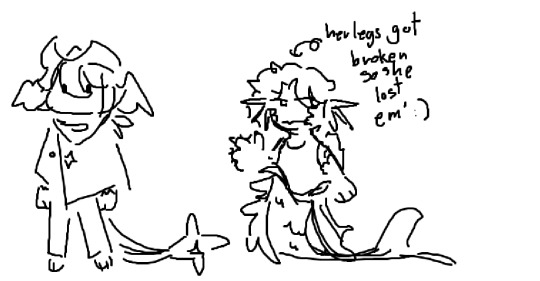
they go from "eh not that monster lookin"(clover who still has human anatomy/ bone structures) to " that's a human? i mean i guess i can see it a bit???" (cyan/first human)
(lmao integrity lost her legs but at least you can tell she was human at some point :D)
#“Lucky” Clover Au#art#sorry for the tags#drawing#uty#uty clover#100% making patience frog themed#but that's for me to keep in my brain forever and never draw#asks
32 notes
·
View notes
Text
moodboard tag game
i love this it's exactly the fun i am needing rn. thank you for the tags my darlings @lumoverheaven & @mrsmando 🩵
rules: favourite time of day, favourite aesthetic, a colour that describes you, favourite quote, current obsession, favourite texture, favourite outfit (or one you wish you had in your closet), a world, place or universe that you see yourself living in, favourite flower 🫶🏻




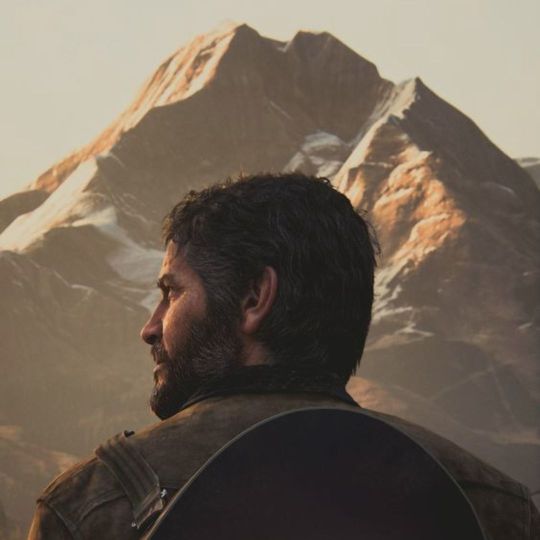




npt ; @5oh5 @familyvideostevie (!!!!! water gun!!!!) @bageldaddy @joelscruff @hellowoolf and if you see this then i tag you, too 🫵🏼
#asked kiddo what color describes me and she said yellow#asked her to pick again cause it didn't fit The Vibe but she remained adamant and said quote: 'that's how i feel when i'm with you' and -#like... ??? shut up you're crying ??????? i'm not c rying don't look at me#frog do tag
37 notes
·
View notes
Text


Emmy x charlotte that lives together as a photographer and model for Day 6 Happily Ever After.
Requested by:n/a
-Mod rapunzel
#edit#Self request#moodboard#mod rapunzel#crossover#crossover ship#non/disney#disney femslash week#Disney femslash#crossover femslash#Professor layton#the princess and the frog#Emmy altava#charlotte la bouff#Emmy x charlotte#Pinkcore#Yellowcore#ask to tag
24 notes
·
View notes
Note
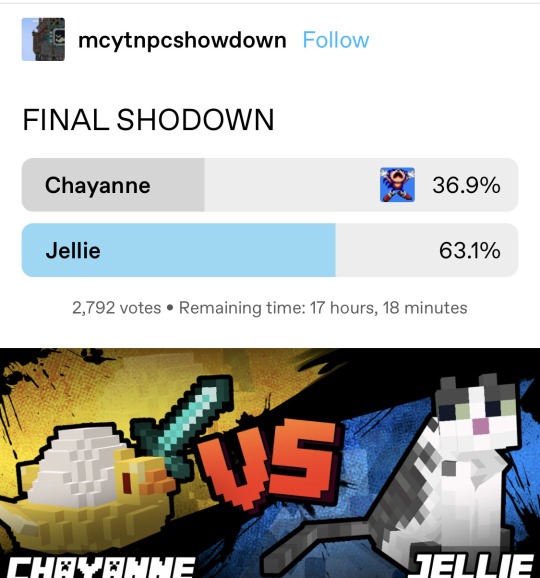
voted for chay :>
could i get a phil surrounded by his harem of men on the island?
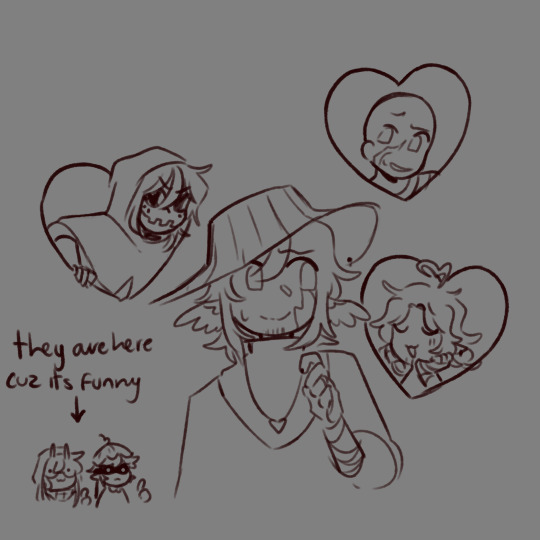
i just put the main ones lol
(vote for chayanne)
86 notes
·
View notes
Text


Digitalized some COTL doodles 👀
#cotl#cult of the lamb#cotl lamb#cotl heket#ask to tag#Am sorry as soon as she was described as being hot-headed all I could think of was those lil angry desert frogs#probably going to upload these two to my redbubble too 👀
41 notes
·
View notes
Note
Hi hi again :D
Saw this RO ask from another blog and got curious SO-- if the ROs were in an orpheus/eurydice situation, would they look back or make it out without looking? (ㆁωㆁ)
ohhh greek myth is my Shit i love this okay
there's honestly less angst than you would expect in these askdh
LOOKS;
A. Bellefleur; they can't bear the thought of not seeing you again, so much so that they just have to be certain you're behind them, that you're there. they never quite recover not getting you back, there's always something about their interactions from then on that feels hollow and...empty
A. Caras; they don't trust like that, especially not with authority. they don't agree to the conditions in the first place, and if/when forced into it they almost immediately turn around. they are smiling sadly, and apologising, asking that you understand why they didn't take 'some lowlife god's' word for it. they wear your favourite flowers in their hair until the day that they die, telling you all about their week when they visit your grave at the weekends
MAKES IT;
K. Valiev; you say you're behind them? they believe you. they have such blind trust in you that they would, quite literally, go to hell and back. they give you the warmest smile upon reaching the surface, welcoming you back with a hug (you notice, despite their calm demeanour, that they squeeze you just a little tighter)
T. Bellefleur; they struggle, they really do, but they make it. they spend the journey sending back witty quips about the scenery, joking that they'll move the both of you into a flower field to make up for the time you've spent in the monochrome of the underworld. when you get to the surface you notice they're shaking as they turn around and look at you, picking you up by the waist and twirling you delightedly when they realise you're right there
M. Serrel; they issue you your own condition, as they start back: if you speak to them before the surface, they will turn back. there is determination in their voice as they say it, and almost immediately after you affirm you've heard, they begin to walk. if you speak again, they turn back, looking at you with a mix of sadness and betrayal as they apologised. if you don't speak then they make it, turning back to face you at the surface with a relieved smile, burying their head in the crook of your neck and apologising profusely
#tag-if#the advisor's game#twine wip#the frog pond#ro ask#ro; a. bellefleur#ro; k. valiev#ro; a. caras#ro; t. bellefleur#ro; m. serrel#i did classics for a-level#this is my Jam#i fuckin love greek/roman myth#i guess that gives away where i'm from as well akshd#i don't know how common 'a-levels' are#i am in fact british though#jester lore jumpscare
41 notes
·
View notes